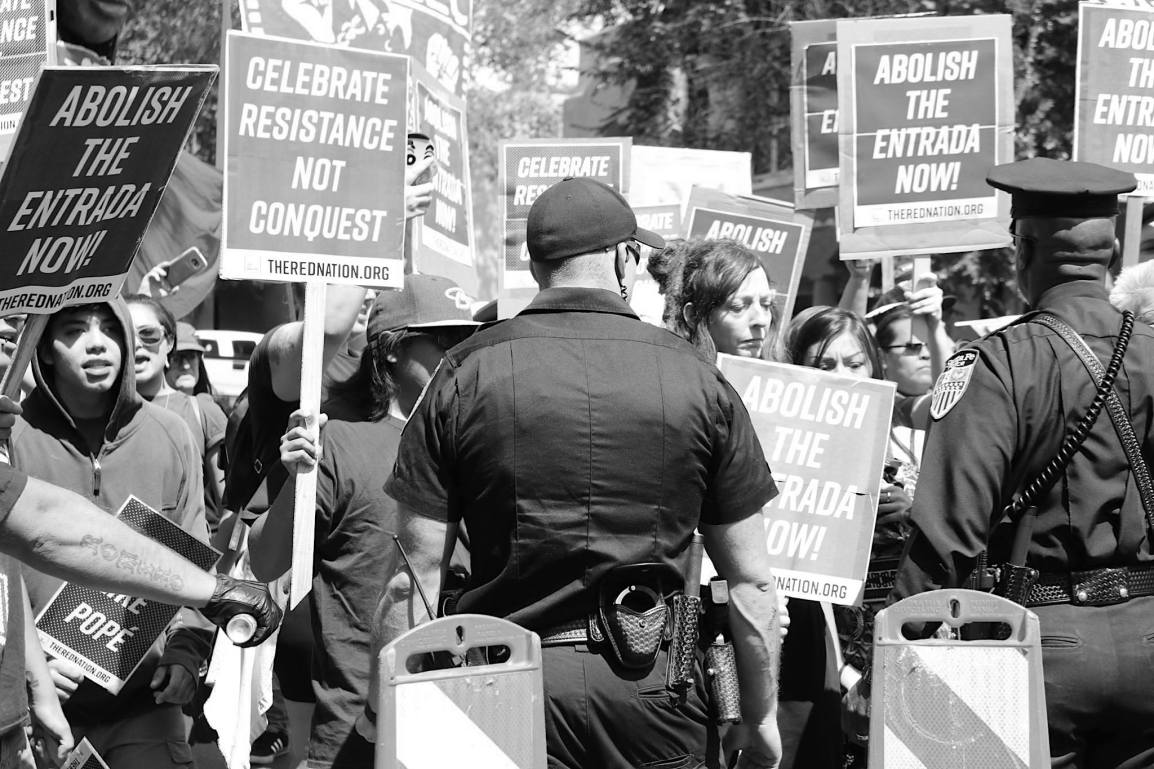
by Christian White
Christian is Kewa Pueblo/Diné, a member of The Red Nation, and a student at the University of New Mexico
I want to reflect on everything I experienced at Friday’s Entrada protest, but, like many, I find it difficult to put words to the way I feel. I definitely can’t ignore my own thoughts of maliciousness or acquiescence, which interfereds with my ability to think, feel, and do. Friends wrote me about their experiences of trauma, anger, and grief; and knowing my comrades were held as political prisoners at Highway 14; and having that helpless feeling because everything was to be determined in the court system. Then there were those on social media, and in the mainstream media, that viewed our action as aberrant. It is a bit too much.
I am still shocked and numb from seeing my comrades arrested, from being told to go back to the reservation, and from the complete rejection of my own rights and humanity. (Or rather being told what that humanity is.) In doing research on police brutality and border town violence, I always thought of Santa Fe as the less-overt, softer, cousin border town who portrayed itself as a liberal-multicultural paradise. Santa Fe always accepted native culture, art, and people — of course, to profit from and exploit. But as we saw Friday, when that authority is threatened, Santa Fe city officials, Fiesta organizers, the police, and those in attendance were ready to flex their power against peaceful protestors. It was a hard reminder that my existence is always, already viewed as a threat and in danger of state-sanctioned violence.
Even in preparation for the Entrada — in interviews, articles, and in national discourse — the protest was already labeled as vicious, criminal, aberrant, and violent. I hinted (albeit jokingly) about how a journalist was intent on making The Red Nation violent by connecting #SlayLikePopé to #KillLikePopé; and we saw this play out with the increased police presence and regulations against those protesting. This indicated that they weren’t going to treats us as human, but as something less. And that will always be a settler colonial strategy in order to subvert the momentum of Indigenous movements. Those protesting against celebrations of genocide, exploitation, and dispossession, will always be viewed as deviant, or viewed negatively.
But how are those complicit with these racial, colonial, and heteropatriarchal representations of violence portrayed? I will never be able to see how they can celebrate men who perpetuated racial, sexual, and colonial violence against Indigenous people. I don’t think it’s said often enough, but they are, more often than not, given the benefit of the doubt. “They don’t know what they celebrate.” “It’s part of their religion.” Or, my favorite, “it celebrates native people.” There’s always this want to treat those in support of this colonial status quo with kiddie gloves. Everyone and their mayors want to portray this as a “complicated issue” — from the Civil War statues commemorating Southern war generals to the colonial celebrations of re-conquest. And there are always claims from within that these colonial people were different outside the confines of war — or that the colonizers were men of peace with families, friends, and lives. But I ask, can you really separate a man’s military actions from his legacy? More current to today, can you support a mayor who condones violence against Native women?
In either case, those legacies aren’t only celebrated, but the mantle of state-sanctioned violence was taken up, almost as if it was foundational to Santa Fe’s roots.
I was expecting a certain response from the city, but it was a revelation to me to see that level of performance by the police. It was a reiteration of the power that they think they have over Indigenous people. Santa Fe, and any other border town, depends on these demonstrations of power to not only confirm dominance, but to reaffirm its existence as well. However, my existence, my voice, and my work will always be a reminder that history isn’t as two-sided as people think. There is only one history and that history is full of Indigenous resistance, and it’s not stopping anytime soon.
Subscribe: